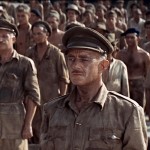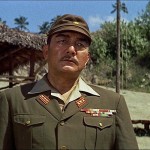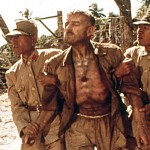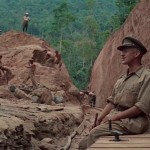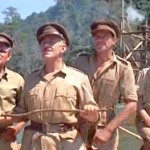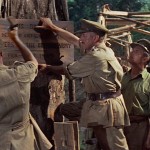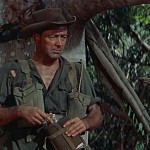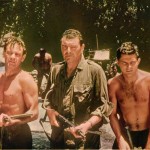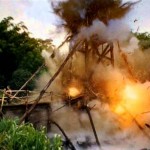
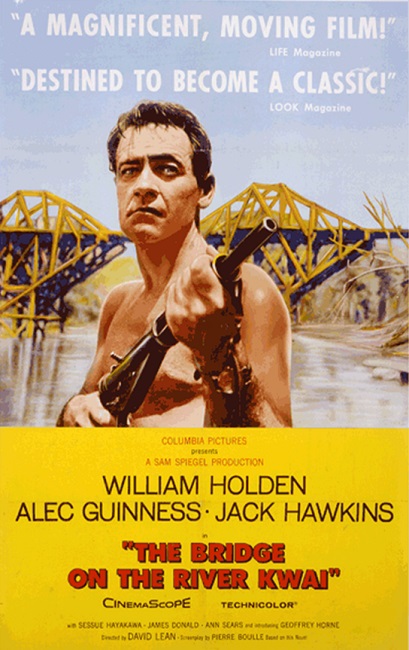
The Bridge on the River Kwai – 1957
Here we go with another World War II movie, this one taking place in Western Thailand. I had seen the film before, so I already knew the plot, though it has been a while. I had forgotten many of the details and found that I enjoyed seeing it again. The climax of the film, in particular, was very intense and well acted. It was one of those scenes in which you see disaster coming and are ready to start shouting at the characters on the screen. “No! No! What are you doing??”
While this movie was a WWII film, it took place away from any fighting or action. The characters are Prisoners of War being held by the Japanese who are using them as laborers to build a bridge. The POWs are Brits under the command of Lt. Colonel Nicholson, played by Alec Guinness. He played the part incredibly well. Right from the very beginning, he is established as the perfect British Soldier. He is always confident, in command, and in control. He takes a certain amount of pride in remaining civilized in an uncivilized situation. Playing opposite Guinness is the Japanese commandant, Colonel Saito, played by Sessue Hayakawa. Saito has been commanded to complete the bridge by a certain date. If he fails in his task, he will be forced to commit ritual suicide. An American soldier who has been in the labor camp for a long time is Navy Commander Shears, played by William Holden. He manages to do the impossible and escape back to the free world. But he is forced to join a task force charged with destroying the bridge at any cost.
Using this as set-up, the rest of the plot can be divided up into three stories. First, there is the power struggle between Saito and Nichols for control of the POWs as an effective labor force. Second, there is the building of the bridge. Third, there is Shears’ escape and the destruction of the bridge. The film gives sufficient time to each of these sub-plots and in the end all three of them come together for a very exciting climax.
Guinness really did a great job in this role. You start off really admiring the character of Colonel Nichols, and gradually you begin to see what his biggest flaw is: pride. He becomes so proud of the bridge he has created that he is blinded to the fact that he has built it for the enemy. And why did he do it? He wanted to prove that the British were better than the Japanese. They were smarter, tougher, and more civilized. It isn’t until the very end when he discovers the plot to destroy the bridge, when he has his “What have I done?” moment. In fact, he actually says those words. Not only has his arrogant pride caused him to build a sturdy bridge for the enemy, but he comes close to foiling the plot to destroy it, getting several people killed in the process, including Colonel Saito, whom he had come to respect.
Interesting note: Though the film was set in Burma, it was filmed mostly in what is now Sri Lanka. The bridge for the film was built over the Kelani River. During filming, director David Lean was nearly drowned when he was swept away by a river current during a break in filming. He was saved by actor Geoffrey Horn who played the part of Canadian Officer Lieutenant Joyce.
There was one aspect of the film that I didn’t particularly care for: the music. There were times when the film score was just fine. The orchestral score complimented the plot and showed up in all the right places. But there were other times when I felt like I was at a college football game. I understand and am OK with the fact that a march tune entitled “Colonel Bogey” was whistled by the POWs marching into the labor camp. That was the only place in the film where the marching band music seemed appropriate to me.
But that being said, there were several places in the movie where the marching band music was used that I just didn’t understand. It was used in such a way that it completely pulled me out of the jungles of Thailand and dropped me in the middle of half-time at the USC Friday night game. For example: when Saito finally let Nicholson out of the hot box, losing a battle of wills, the POWs began to cheer. The marching band music started up again and I thought that someone had just scored a touch-down. The sentiment for victory may have been appropriately accompanied by a victory march, but I found it so distracting that I was taken out of the story. But my opinion regarding the music aside, everyone else seemed to have loved the music. Malcolm Arnold actually won the Academy Award for Best Music.
In fact, the film took home seven Academy Awards in all. Guinness won for Best Actor, David Lean won for Best Director, in addition to Awards for Best Writing, Screenplay Based on Material from Another Medium (which I assume is like the modern Best Adapted Screenplay category), Best Film Editing, and Best Cinematography. Hayakawa was also nominated for Best Supporting Actor.
Interesting note: I found this fun fact while reading Wikipedia. “According to Turner Classic Movies, the producers nearly suffered a catastrophe following the filming of the bridge explosion. To ensure they captured the one-time event, multiple cameras from several angles were used. Ordinarily, the film would have been taken by boat to London, but due to the Suez crisis this was impossible; therefore the film was taken by air freight. When the shipment failed to arrive in London, a worldwide search was undertaken. To the producers’ horror the film containers were found a week later on an airport tarmac in Cairo, sitting in the hot Egyptian sun. Though it was not exposed to sunlight, the heat-sensitive colour film stock should have been hopelessly ruined; however, when processed the shots were perfect and appeared in the film.”
All in all, and despite the marching band music, I enjoyed the film. Guinness did a fantastic job and the climax was very exciting to watch. Even though I knew how the film ended, I was still on the edge of my seat. This was definitely a deserving Best Picture winner!
